About ethernet cable types and speeds,Ethernet cables have evolved to remain relevant despite the emergence of other super-fast connections like fiber optic cables.
This evolution has led to different ethernet cable types and speeds that fit various category cable standards.
We will look at these types and explain their differences in performance. Let’s get right into it!
Table of Contents
- What are Ethernet Cables
- Ethernet Cable Categories/Types
- Ethernet Cable Defining Factors
- Ethernet Cable Shielding Types
- Conclusion
What are Ethernet Cables
At first glance, ethernet cables resemble thicker, bulkier versions of regular telephone cords. But they are different.
Ethernet is an agreed-to electrical signal format used for communication between devices. The technology evolved from thick coaxial cables (copper conductor-based) to modular twisted pair cables.
These twisted pairs come in several construction standards (category ratings) that determine the throughput specifications and signal quality.
Why We Use Twisted Wire Pairs
An ethernet cable’s internal conductors consist of twisted pairs, but not many people understand why we use them.
Copper wires transport electrical energy using compression waves that travel through the electrons inside the wire.
But the energy does not travel in the electrical wires like water moving through a pipe or sound in the air.
Instead, it travels in the space around the conductor. Therefore, this energy is susceptible to interference (crosstalk) caused by electromagnetic radiation.
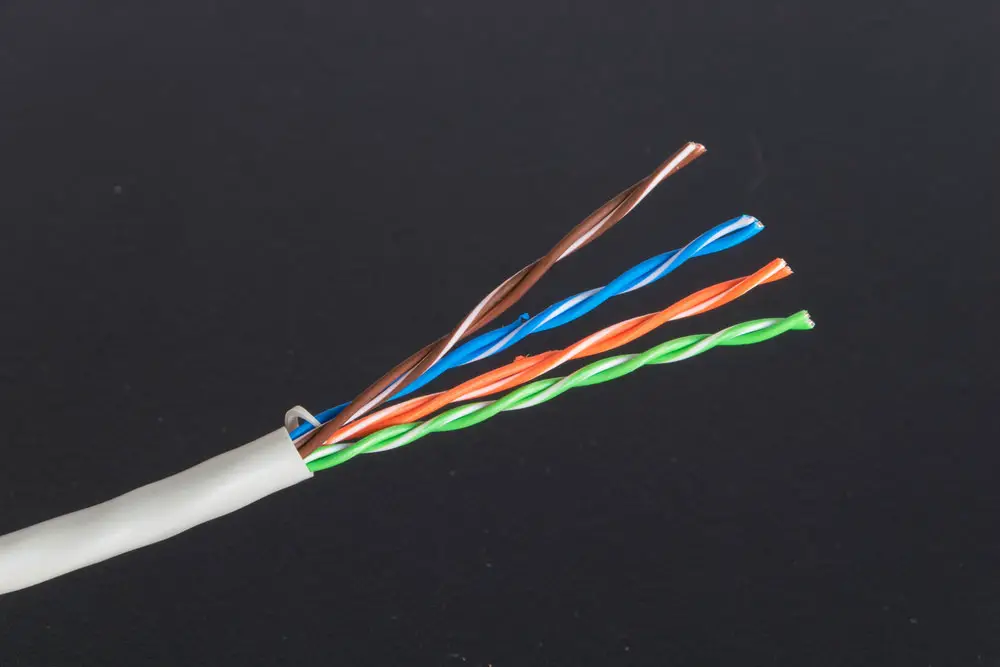
A twisted pair cable with four wire pairs
However, twisting two wires together reduces the chances of crosstalk occurring. Alexander Graham Bell made this discovery in 1881, making twisted wire pairs the industry standard.
Ethernet Cable Categories/Types
As stated earlier, twisted pair cabling comes in several category ratings defining their types. They include the following.
Cat1 to Cat5 Cable
These categories are old and technically are unofficial ethernet cable standards. Let’s look at them briefly.
Cat1
This unshielded twisted pair cord was typical in voice telephone systems for analog voice communication. It consists of two twisted insulated copper wires.
Cat2
Cat2 cables are capable of data & voice communication and handle a data transmission rate of 4 Mbps. The cords were typical in the 80s in connecting IBM token ring networks.

A ring topology network
Cat3
These cables hit the market in the early 90s and featured four twisted pairs. They were the first to support 10BaseT Ethernet (10 Mbps) plus digital voice communications.
Cat4
Cat4 cables were faster than their Cat3 predecessors by 6 Mbps and were typical in IBM token ring networks.
Cat5
These cables are ideal for 10BaseT and 100BaseT ethernet networks. Introduced in 1995, they can transmit voice, data, and phone signals at distances of up to 100 meters or 328 feet.
With speeds of up to 100 Mbps, the Cat5 ethernet cable has a 1:1 ratio with its bandwidth, meaning it can handle up to 100 MHz. But you might get faster speeds if the cord is shorter than 100 meters.
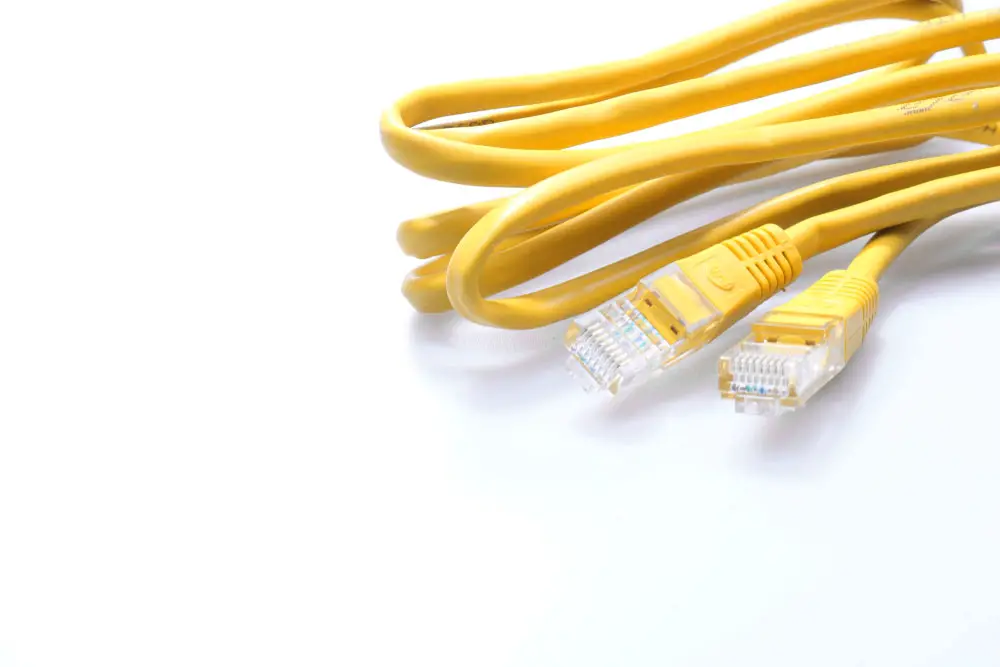
A Cat5 cable
Cat5e
Cat5e does not fall into the old category above because some networks still run them, and they are relatively fast. The “e” means it is an enhanced version of the Cat5 cable.
Although there are no physical differences between the two cables, Cat5e features stringent construction standards, like two twists per centimeter, to reduce crosstalk & signal degradation and increase transmission speeds.
So the cable can support 1 Gbps (1,000 Mbps), making it 10x faster than Cat5. Plus, it can support higher bandwidth frequencies of up to 250 MHz.
These high speeds and low production costs make Cat5e the most common cable in networking applications.
Cat6
These cables also contain four twisted pairs but are more tightly wound and feature splines between the four pairs to minimize crosstalk and interior system noise.
Also, they have thicker copper conductors to increase their capacity and thick outer sheaths to increase their resilience to alien crosstalk.
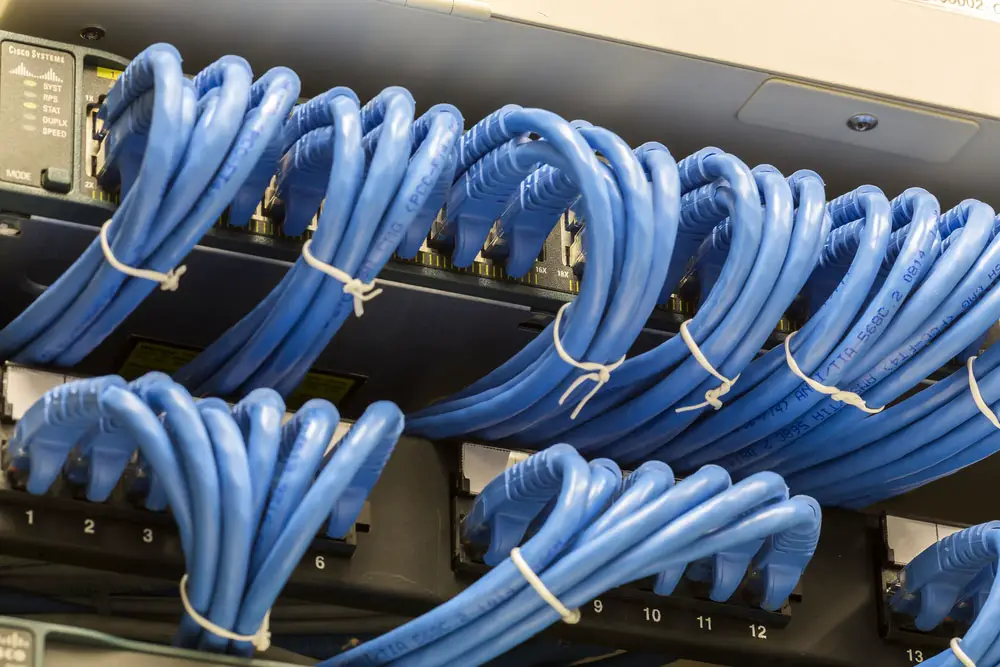
Cat6 ethernet cables used to connect servers in a data center
With these advancements, the cables support transmission speeds of up to 10 Gbps for up to 55 meters at a maximum bandwidth of 500 MHz.
However, the Cat6 ethernet cable is expensive. But it is backward compatible with Cat5/5e standards.
Cat6a
The “a” implies the cables are augmented versions of their Cat6 counterparts. Augmentation means the pairs of copper wires are thicker and have an outer foil shield with thicker sheathing than Cat6.
Although this construction standard makes them less flexible and denser, Cat6a ethernet cables have higher transmission speeds over long distances.
They can maintain speeds of 10 Gbps for 100 meters at a maximum frequency of 500 MHz.
But the less flexible cables are expensive and ideal for industrial applications because they are too stiff for residential deployment.
Cat7
This new F-class cable type supports up to 10 Gbps at 600 MHz. But lab tests have shown they can attain 40 Gbps at 50 meters and 100 Gbps in extreme cases.
Such speeds are ideal for large enterprise networks and data centers.
This performance is possible due to robust foil shielding that minimizes signal attenuation caused by electromagnetic interference.
The shielding makes the cables stiffer than their Cat6a counterparts, so they are ideal for data centers.
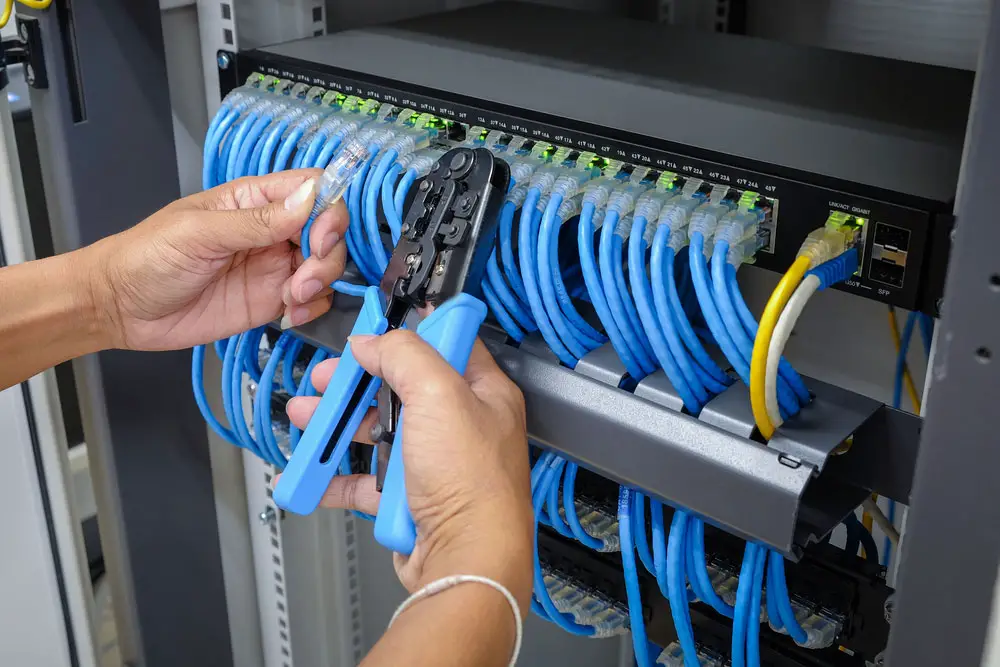
A network engineer holding an ethernet cable to connect to a server in a data center
The cables run on a GigaGate45 connector that is backward compatible with RJ45 connectors.
However, the modified ethernet cable connector is a proprietary product, which made most manufacturers avoid the Cat7 ethernet standard.
So this cable is not popular and common.
Cat7a
Like with Cat6a, this higher-category cable is an augmented version of the Cat7 standard.
It offers the same Gigabit ethernet speeds as Cat7 but has a slightly higher bandwidth capacity (1 GHz).
But these cables are not popular because they are expensive and lack IEEE & EIA support.
Cat8
Cat8 cables offer top-of-the-line performance, promising up to 40 Gbps at 30 meters at a high-frequency electrical signal of 2,000 MHz (2 GHz).
It achieves this performance by wrapping each twisted pair in a foil.
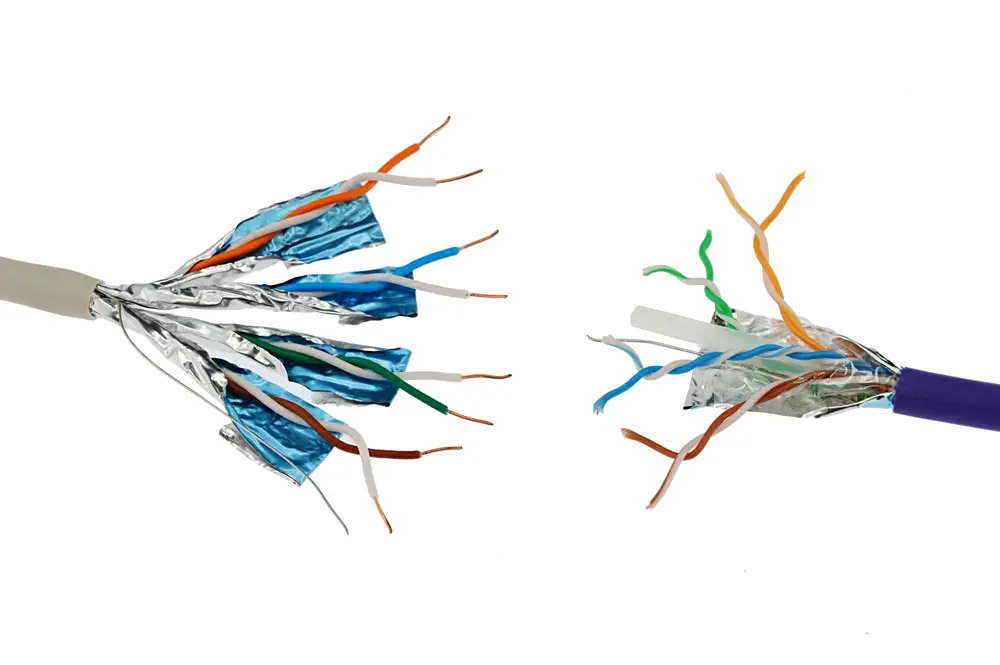
A twisted pair cable with each pair individually wrapped in foil
The cable works with 25 and 40BaseT Gigabit ethernet, which reduces power consumption and can handle data-intensive data center applications.
Since Cat8 cables meet the latest IEEE standards and their Gigabit speeds future-proof the network, it is advisable to skip Cat7/7a and go straight to this cable.
Ethernet Cable Defining Factors
As you might have noticed above, ethernet cables have these two defining factors.
Bandwidth
Measured in MHz frequency, bandwidth gives the rate at which the electrical ethernet signal cycles each second.
1 MHz is equivalent to 1,000,000 cycles per second, and the cable with the highest bandwidth is Cat8 (two billion cycles per second).
High frequencies carry more data (0 and 1) per second, allowing fast data transmission speeds.
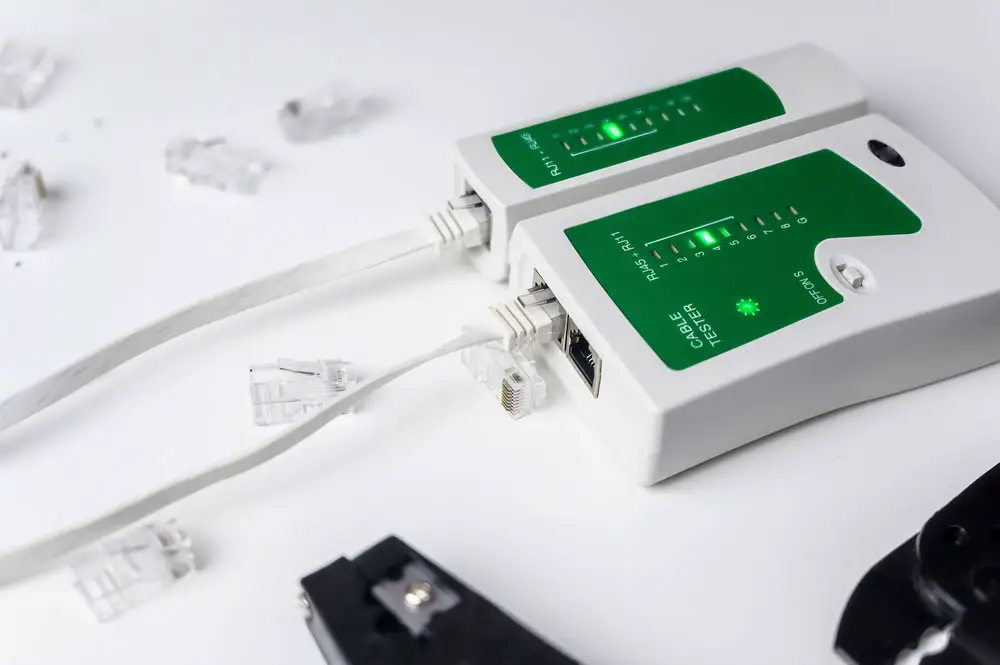
An ethernet cable test tool checking a Cat5 UTP cable
Cat5 cables have a 1:1 ratio between the bandwidth and transfer rate, meaning they can handle a maximum transmission speed of 100 Mbps.
But Cat8 cables can encode more bits per second, leading to higher transmission rates.
Data Transfer Rate
This factor defines how many data bits can travel through the cable each second.
So the two terms relate closely because an increase in frequency raises the bandwidth. But they are not the same.
You can increase the frequency by using heavier gauge cable, increasing the number of twists per centimeter, or using a shielded twisted pair.
Ethernet Cable Shielding Types
Since shielding also affects cable performance, we will examine the shielding types available for these twisted wire pairs.
UTP (Unshielded Twisted Pair)
This network cable consists of four twisted pairs with only the plastic insulation around the wires and an outer cable jacket.
But it can come in two other variants to help reduce signal interference.
These include F/UTP (unshielded twisted pair with an outer foil shield) and S/UTP (unshielded twisted pair with an outer braided shield).

An unshielded twisted-pair cable
STP (Shielded Twisted Pair)
Shielded twisted pair cabling features a copper-braid jacket around the individual pair, with a cable jacket covering all four shielded pairs. Like UTP, STP comes in several variations.
FTP (Foiled Twisted Pair)
Instead of having a copper-braid jacket, FTP cables feature foil shields or screens around each pair. And they are available in several variations with different construction standards.

A foil-shielded cable
Conclusion
As you can see, all ethernet cables contain pairs of conductor wires. But each type has different construction standards.
These standards differ depending on the solid copper wire thickness, shielding, and twisting per centimeter.
Higher-category cables have thick gauge copper wires with more twists and shields/foils, enabling them to achieve fast network speeds and bandwidths.
However, they are costlier. So always consider your application and speed requirements first, then pick the right ethernet category for your project.
